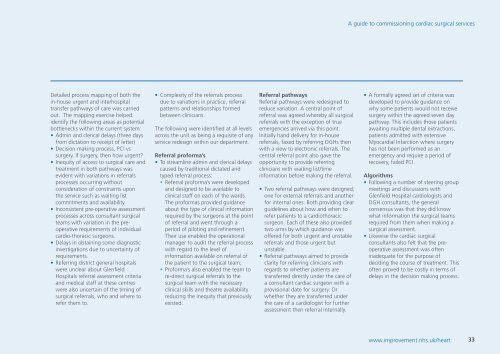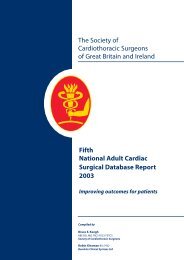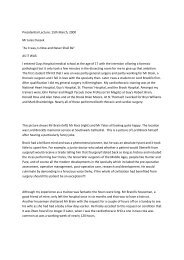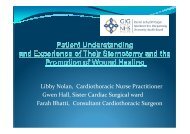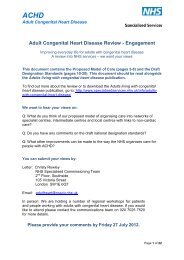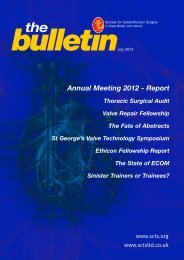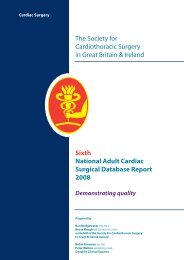A guide to commissioning cardiac surgical services - NHS ...
A guide to commissioning cardiac surgical services - NHS ...
A guide to commissioning cardiac surgical services - NHS ...
You also want an ePaper? Increase the reach of your titles
YUMPU automatically turns print PDFs into web optimized ePapers that Google loves.
A <strong>guide</strong> <strong>to</strong> <strong>commissioning</strong> <strong>cardiac</strong> <strong>surgical</strong> <strong>services</strong><br />
Detailed process mapping of both the<br />
in-house urgent and interhospital<br />
transfer pathways of care was carried<br />
out. The mapping exercise helped<br />
identify the following areas as potential<br />
bottlenecks within the current system:<br />
• Admin and clerical delays (three days<br />
from dictation <strong>to</strong> receipt of letter)<br />
• Decision making process, PCI vs<br />
surgery. If surgery, then how urgent?<br />
• Inequity of access <strong>to</strong> <strong>surgical</strong> care and<br />
treatment in both pathways was<br />
evident with variations in referrals<br />
processes occurring without<br />
consideration of constraints upon<br />
the service such as waiting list<br />
commitments and availability.<br />
• Inconsistent pre-operative assessment<br />
processes across consultant <strong>surgical</strong><br />
teams with variation in the preoperative<br />
requirements of individual<br />
cardio-thoracic surgeons.<br />
• Delays in obtaining some diagnostic<br />
investigations due <strong>to</strong> uncertainty of<br />
requirements.<br />
• Referring district general hospitals<br />
were unclear about Glenfield<br />
Hospitals referral assessment criteria<br />
and medical staff at these centres<br />
were also uncertain of the timing of<br />
<strong>surgical</strong> referrals, who and where <strong>to</strong><br />
refer them <strong>to</strong>.<br />
• Complexity of the referrals process<br />
due <strong>to</strong> variations in practice, referral<br />
patterns and relationships formed<br />
between clinicians.<br />
The following were identified at all levels<br />
across the unit as being a requisite of any<br />
service redesign within our department.<br />
Referral proforma’s<br />
• To streamline admin and clerical delays<br />
caused by traditional dictated and<br />
typed referral process:<br />
• Referral proforma’s were developed<br />
and designed <strong>to</strong> be available <strong>to</strong><br />
clinical staff on each of the wards.<br />
The proformas provided guidance<br />
about the type of clinical information<br />
required by the surgeons at the point<br />
of referral and went through a<br />
period of piloting and refinement.<br />
Their use enabled the operational<br />
manager <strong>to</strong> audit the referral process<br />
with regard <strong>to</strong> the level of<br />
information available on referral of<br />
the patient <strong>to</strong> the <strong>surgical</strong> team;<br />
• Proforma’s also enabled the team <strong>to</strong><br />
re-direct <strong>surgical</strong> referrals <strong>to</strong> the<br />
<strong>surgical</strong> team with the necessary<br />
clinical skills and theatre availability<br />
reducing the inequity that previously<br />
existed.<br />
Referral pathways<br />
Referral pathways were redesigned <strong>to</strong><br />
reduce variation. A central point of<br />
referral was agreed whereby all <strong>surgical</strong><br />
referrals with the exception of true<br />
emergencies arrived via this point.<br />
Initially hand delivery for in-house<br />
referrals, faxed by referring DGHs then<br />
with a view <strong>to</strong> electronic referrals. The<br />
central referral point also gave the<br />
opportunity <strong>to</strong> provide referring<br />
clinicians with waiting list/time<br />
information before making the referral.<br />
• Two referral pathways were designed;<br />
one for external referrals and another<br />
for internal ones. Both providing clear<br />
<strong>guide</strong>lines about how and when <strong>to</strong><br />
refer patients <strong>to</strong> a cardiothoracic<br />
surgeon. Each of these also provided<br />
two arms by which guidance was<br />
offered for both urgent and unstable<br />
referrals and those urgent but<br />
unstable.<br />
• Referral pathways aimed <strong>to</strong> provide<br />
clarity for referring clinicians with<br />
regards <strong>to</strong> whether patients are<br />
transferred directly under the care of<br />
a consultant <strong>cardiac</strong> surgeon with a<br />
provisional date for surgery. Or<br />
whether they are transferred under<br />
the care of a cardiologist for further<br />
assessment then referral internally.<br />
• A formally agreed set of criteria was<br />
developed <strong>to</strong> provide guidance on<br />
why some patients would not receive<br />
surgery within the agreed seven day<br />
pathway. This includes those patients<br />
awaiting multiple dental extractions,<br />
patients admitted with extensive<br />
Myocardial Infarction where surgery<br />
has not been performed as an<br />
emergency and require a period of<br />
recovery, failed PCI.<br />
Algorithms<br />
• Following a number of steering group<br />
meetings and discussions with<br />
Glenfield Hospital cardiologists and<br />
DGH consultants, the general<br />
consensus was that they did know<br />
what information the <strong>surgical</strong> teams<br />
required from them when making a<br />
<strong>surgical</strong> assessment.<br />
• Likewise the <strong>cardiac</strong> <strong>surgical</strong><br />
consultants also felt that the preoperative<br />
assessment was often<br />
inadequate for the purpose of<br />
deciding the course of treatment. This<br />
often proved <strong>to</strong> be costly in terms of<br />
delays in the decision making process.<br />
www.improvement.nhs.uk/heart<br />
33


